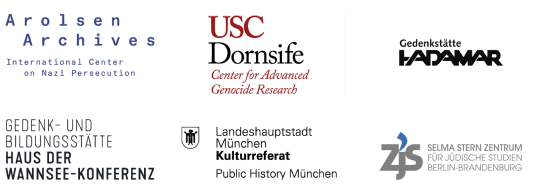Annotations
Würzburg
April 1942
The deportees pass Martin-Luther-Straße. In front on the right: the carriage of the Richard Nickel film company.
Annotations
Keywords
4
Historical context
Deportation von Würzburg nach Kraśniczyn am 25.04.1942
The Platz'scher Garten outdoor restaurant at Friedrich-Ebert-Ring 2-3 served as assembly point for the third deportation of 852 Jews from the administrative district of Lower Franconia. Pursuant to invoice, the Gestapo paid the owner a rent of RM 1,663.69 for using the restaurant to this end. Starting from April 22, 1942, the people to be deported had to report to the assembly point, where they underwent processing, body search included. On April 25, by day, a forced march to Würzburg central station ensued; the train DA 49 left Würzburg at 3:20 p.m., and more people were forced to board in Bamberg and other places. On April 28 at 8:45 in the morning, the train reached Krasnystaw near Lublin. Hereafter, the deportees had to continue their journey to Kraśniczyn on foot. The Jewish inhabitants of that place had been murdered the day before. The Jews deported via Würzburg most likely were taken to Sobibor on June 6, 1942 and murdered there.
About the image series
The picture series consists of at least 59 photos in the format 6 – 7,1 x 9,1 – 10,1 cm. Since the pictures were glued to file covers and preserved in an album format, there are no images of the pictures’ backs. The album includes photographs of three deportations that were implemented by the Würzburg branch office of the Gestapo. Handwritten antisemitic comments were added to the Würzburg photos from April 1942. The picture series shows the details of the deportation process: the deportees’ arrival at the Platz'scher Garten assembly point, their processing, waiting and forced march across the city to Würzburg's central station. One part of the series is kept at Staatsarchiv Würzburg (Würzburg State Archives), another at the United States Holocaust Memorial Museum (USHMM). The chronological order of the images cannot be reliably restored.
Photographer
Hermann Otto, senior criminal assistant
On instructions of the Nuremberg police chief, Dr. Martin, criminal assistant Hermann Otto kept a detailed photographic record of the deportations in the area of responsibility of the Würzburg Gestapo. Although criminal assistant Balthasar Lutz was also commissioned to photograph, only Hermann Otto took the pictures.
Hermann Otto, born in Würzburg in 1896, was a trained stone sculptor. He volunteered for the military in 1914 and joined the Bavarian State Police in 1922. Since 1938, he had been working for the Würzburg Gestapo. Starting from the summer of 1942, Hermann Otto was seconded to work in occupied Eastern Europe, his last post being with the security police in Belarus. He had been considered missing in action since June 27, 1944. In 1948, a denazification tribunal found him to be a “follower".
Provenance
The series is part of a photo album created by the Würzburg Gestapo that shows the deportations from Würzburg and Kitzingen in November 1941, March 1942, and April 1942. After its discovery by Isaac Wahler, a U.S. soldier who had been born in Nuremberg, the album was used as evidence in the Nuremberg trials and in the Eichmann trial. Copies of single photographs and of the entire album have survived in various archives. The whereabouts of the original album had been unclear for decades until historian Dr. Edith Raim recovered it in the early 2000s. Twenty-four of the original 28 file covers that make up the album are kept in Würzburg; the whereabouts of the other four are unclear. Nineteen images are copies from the United States Holocaust Memorial Museum (USHMM), which can be traced back to Isaac Wahler.
Call number at source archive
Photograph Number: 18910
Title at source archive
Jewish deportees, carrying a few personal belongings in bundles and suitcases, march through town along the Hindenburgstrasse from the assembly center at the Platzscher Garten to the railroad station.
Acknowledgements
The present description is based on the volume "Wege in die Vernichtung. Die Deportation der Juden aus Mainfranken 1941 bis 1943" (Paths to Extinction. The Deportation of Jews from Mainfranken 1941 to 1943) published by the directorate general of the state archives in Bavaria. We would like to express our sincere thanks to the Würzburg State Archives for the opportunity to inspect fonds 18880a in detail and for their support of the project.
Text and research by Alina Bothe.
Kooperationsverbund #LastSeen. Bilder der NS-Deportationen Dr. Alina Bothe Projektleiterin
c/o Selma Stern Zentrum für Jüdische Studien Berlin-Brandenburg
Freie Universität Berlin
Habelschwerdter Allee 34A
14195 Berlin
lastseen@zedat.fu-berlin.de
Ein Kooperationsprojekt von

Gefördert durch

Datenschutz | Impressum